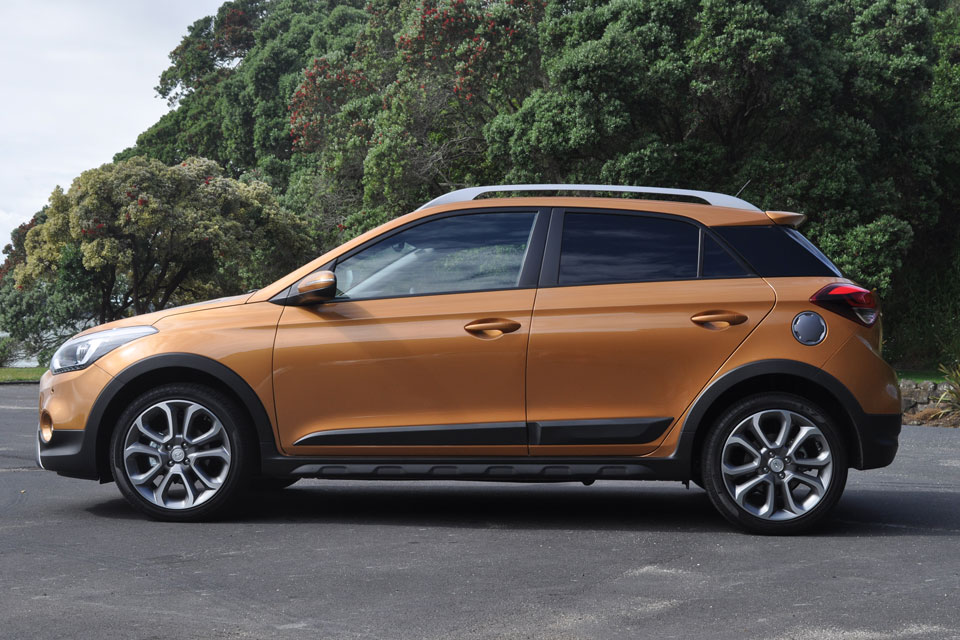Hyundai i20 Cross 2017 new car review
The Hyundai i20 spearheads a refreshed attack on the city car segment but also bites into the growing light SUV market.

Hyundai New Zealand is hoping that the new i20 Cross with its stylish plastic cladding, roof rails and raised ride height, will not only spearhead a refreshed attack on the city car segment but also bite into the growing light SUV market.
We like the new exterior design of the tough-looking i20 Cross — particularly the lower and wider stance, which makes the car appear bigger on the road than its predecessor.
Hyundai has developed a small car that looks and feels attractive, as well as handle nicely while retaining its functional and practical character. We drove the i20 cross on an extended three-week test over the Christmas-New Year break, discovering a few niggles along the way.
Well equipped
While both the i20 hatch and the i20 Cross are well equipped with safety features, the lack of an autonomous emergency braking system means under European crash testing rules, it has only received a 4-star safety rating.
Standard equipment on both versions of the i20 includes automatic dusk-sensing projector headlights with LED daytime running lights, a backing camera, cruise control with a speed limiter, rain-sensing wipers, tyre pressure monitoring, a lane departure warning system, and hill-start assist.
The i20 hatch wears 16-inch alloy wheels, while the i20 Cross wears 17-inch alloys shod with Pirelli tyres. Adding an integrated nudge bar, a front skid plate, round fog lights, horizontal grille bars, black wheel arch trim and lower body mouldings, a rear skid plate and moulded lower fascia, plus a 20mm rise in ride height also differentiates the i20 Cross from the i20 hatch.
Four-speed automatic disappoints
First, let us dispense with the elephant in the room. The Turkish-built i20 arrives with a 1.4-litre four-cylinder petrol engine which, surprisingly is matched with a four-speed automatic transmission. However, the industry has generally moved towards more efficient, continuously variable transmissions or six-speed automatics.
With 74kW and 130Nm available, acceleration off the line is leisurely, unless you press the pedal to the metal, in which case the momentum picks up, along with engine and transmission noise. Fuel consumption also suffers.
At a steady cruising speed of 100kmh the i20's Kappa engine is spinning at nearly 3000rpm, and while it's relatively quiet when doing so, you still feel the car could use a higher gear.
Our overall average fuel consumption figure of 9-litres per 100km was also nowhere near the combined 6.7-litres per 100km quoted by Hyundai. For some buyers such as low mileage retirees, or a family needing a second vehicle for the school run, this won't be a concern. For others, such as higher-mileage pool car and fleet users, it may be.
European indicators
As with any small car, the devil is in the details and the i20 Cross is no exception. It's European design, and Turkish production shows up with the indicator mounted on the left-hand side of the steering wheel. No issue once you are used to the car, but if you are jumping from one Hyundai to another you will accidentally operate the windscreen wipers instead of the indicators a few times.
The tiny audio control screen in the middle of the dashboard was also disappointing as it relegated the reversing camera screen to a small section of the rear vision mirror. This doesn’t provide the size, depth and clarity we like.
The lack of a decently sized screen also negated the car from offering integrated mobile phone features such as Android Auto or Apple CarPlay, which Hyundai offers in many of its other passenger vehicles.
City slicker
The i20 Cross comes into its own as a city commuter, thanks to its excellent turning circle, good handling, and comfortable ride quality — even wearing a more performance orientated wheel and tyre combination.
The boot space has a false floor which allows you to hide the Hyundai-supplied first aid kit and other travelling necessities. The one rattle we could detect in the i20 Cross came from the O-ring pin of the standard fire extinguisher. A nice touch from Hyundai.
SUV looks without bulk
Despite the raised ride height and roof rails, Hyundai New Zealand might be a bit optimistic in viewing the i20 Cross as a small SUV contender. But some people will appreciate the looks without the size and bulk.
It is however far more likely that the i20 Cross will end up in the garages of current i20 and other light car owners, such as retirees and single professionals looking to upgrade to a more attractive vehicle which is still functional and practical.
Price: $27,990
Note: This was reviewed as a new vehicle.
Image gallery
Also consider





